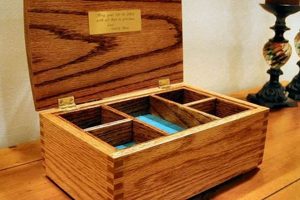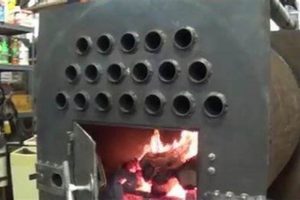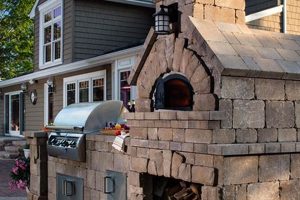A self-constructed, wood-fired bathing vessel represents a cost-effective and environmentally conscious approach to personal relaxation. These installations utilize the combustion of wood as the primary heat source, circulating warmed water within a contained basin for therapeutic or recreational purposes. The defining characteristic is the owner’s active participation in the design, sourcing of materials, and assembly, rather than purchasing a pre-fabricated system.
The appeal of building a personal wood-fueled spa stems from factors beyond mere economics. It allows for customization to specific spatial constraints and aesthetic preferences. Furthermore, it connects individuals to a historical practice of water heating while reducing reliance on electricity or fossil fuels. This alternative aligns with principles of sustainable living and offers a unique sense of accomplishment through hands-on creation.
Subsequent sections will delve into key considerations for planning and executing such a project. This includes a discussion of material selection, safe construction practices, efficient heating methods, and legal compliance to ensure a successful and responsible outcome.
Construction and Operation Guidance
The following recommendations provide crucial insight for the successful creation and maintenance of a wood-fired bathing unit. Adherence to these points will contribute to safety, efficiency, and longevity.
Tip 1: Material Selection is Paramount: Prioritize weather-resistant woods like cedar or redwood for the tub structure itself. These species exhibit natural rot resistance, minimizing the need for chemical treatments. For the firebox, use heavy-gauge steel designed to withstand intense heat and corrosion.
Tip 2: Proper Water Circulation Enhances Efficiency: Implement a thermosiphon system or a small, submersible pump to circulate heated water from the firebox throughout the tub. This ensures even temperature distribution and prevents localized overheating.
Tip 3: Maintain Adequate Clearance Around the Firebox: Establish a non-combustible zone around the firebox, extending several feet in all directions. This reduces the risk of accidental fires and complies with safety regulations. Use fire-resistant materials like concrete or stone for this zone.
Tip 4: Implement a Robust Water Filtration System: Install a filtration system to remove debris and maintain water clarity. This may involve a sand filter, cartridge filter, or a combination thereof. Regular filter maintenance is crucial for hygiene and water quality.
Tip 5: Precise Temperature Control is Essential: Incorporate a reliable thermometer to monitor water temperature. Avoid exceeding a safe bathing temperature, typically around 104F (40C). Develop a method for adjusting the fire to regulate heat output.
Tip 6: Implement a secure drainage system: Design the install with a well installed drain system so that the entire unit can be drained quickly and safely. It also prevents water contamination during non-use by preventing stagnant water for extended periods.
Tip 7: Establish a Regular Maintenance Schedule: Regularly inspect the tub structure, firebox, and plumbing for signs of wear, corrosion, or leaks. Promptly address any issues to prevent further damage and maintain optimal performance.
Tip 8: Always Supervise During Use: Never leave the bathing unit unattended while it is in use, particularly when children are present. Ensure that all users are aware of safety precautions and temperature limits.
By adhering to these guidelines, constructors enhance the safety and longevity of the wood-heated unit. Proper construction and maintenance are key to ensuring a relaxing and secure bathing experience.
The concluding section will summarize the principal considerations covered within this document.
1. Material Durability
The operational lifespan and safety of a self-assembled, wood-fired bathing vessel are intrinsically linked to the durability of the materials employed in its construction. Material selection dictates the system’s ability to withstand the stresses imposed by constant exposure to moisture, fluctuating temperatures, and the corrosive effects of wood combustion byproducts. Failure to prioritize robust materials inevitably leads to premature degradation, compromising structural integrity and potentially resulting in hazardous conditions. For example, using untreated pine for the tub walls, rather than rot-resistant cedar or redwood, guarantees rapid decay and eventual collapse due to fungal growth and water damage. Similarly, thin-gauge steel in the firebox is susceptible to burnout from repeated exposure to high temperatures, creating a fire hazard and rendering the entire system inoperable.
The choice of materials extends beyond the primary structural components to encompass all elements in contact with water or heat. Plumbing fittings must be corrosion-resistant, such as brass or stainless steel, to prevent leaks and contamination. The firebox door and chimney should be constructed from durable metal capable of withstanding extreme heat without warping or cracking. Sealants and adhesives used in assembly must maintain their integrity under constant moisture and temperature fluctuations. Failure to adhere to these requirements results in costly repairs, frequent replacements, and an increased risk of system failure. The initial investment in durable materials offers a demonstrable return in the form of extended service life and reduced maintenance burdens.
In conclusion, the connection between material durability and the longevity of a wood-burning bathing unit is undeniable. Prioritizing resilient and appropriate materials is not merely a matter of aesthetic preference, but a fundamental requirement for ensuring safe, reliable, and cost-effective operation. A thorough understanding of material properties and their response to the operating environment is paramount to a successful outcome. Therefore, investment in appropriate materials and construction techniques ultimately dictates the long-term value and safety of the system.
2. Combustion Efficiency
Combustion efficiency is a critical determinant of operational cost, environmental impact, and overall user satisfaction in any self-built, wood-fired bathing system. The completeness of fuel combustion directly influences the amount of heat generated per unit of wood consumed, impacting both the heating time and the long-term fuel expenses. Furthermore, efficient combustion minimizes the production of smoke and harmful emissions, contributing to environmental responsibility and regulatory compliance.
- Firebox Design and Airflow
The firebox geometry and the provision of adequate airflow are paramount for achieving complete combustion. A well-designed firebox promotes turbulent mixing of fuel and air, ensuring that all combustible gases are oxidized. Insufficient airflow results in incomplete combustion, producing smoke and reducing heat output. Examples of effective designs incorporate secondary air inlets to burn uncombusted gases, maximizing energy extraction and minimizing particulate emissions. The improper design will result in excess smoke and wasted fuel.
- Fuel Type and Moisture Content
The type of wood used and its moisture content significantly impact combustion efficiency. Denser hardwoods, such as oak or maple, generally yield more heat per unit volume than softwoods. However, wood with high moisture content requires a substantial amount of energy to evaporate the water before it can effectively burn, drastically reducing efficiency. Seasoned wood, with a moisture content below 20%, is essential for achieving optimal combustion. Burning wet wood leads to reduced heat output, increased smoke production, and the accumulation of creosote in the chimney.
- Insulation and Heat Transfer
Effective insulation of the firebox and associated heat transfer components minimizes heat loss and maximizes the transfer of heat energy into the water. Insulating the firebox walls reduces radiant heat loss, directing more heat towards the water jacket or heat exchanger. The design of the heat transfer system is crucial for efficient heat exchange. Options include direct immersion of the firebox in the water, or the use of external heat exchangers. Efficient heat transfer minimizes energy waste and reduces the amount of wood required to maintain the desired water temperature.
- Chimney Design and Draft
The chimney design plays a critical role in creating adequate draft, which is essential for sustaining efficient combustion. A properly sized and constructed chimney creates a negative pressure that draws air through the firebox, supplying the oxygen necessary for complete combustion. Insufficient chimney height or diameter restricts airflow, leading to incomplete combustion and smoke buildup. Conversely, excessive draft can result in rapid burning and inefficient heat transfer. Proper chimney design balances airflow to optimize combustion and minimize heat loss.
The interplay of these facets directly affects the performance of the user-built, wood-fired bathing unit. By prioritizing optimal firebox design, using seasoned wood, implementing effective insulation, and ensuring proper chimney draft, builders can significantly enhance combustion efficiency. The consequence is reduced fuel consumption, decreased emissions, and improved overall user satisfaction and environmental impact of the wood-fired system.
3. Water Circulation
Effective water circulation is a non-negotiable element in the functionality and safety of a self-constructed, wood-fired bathing unit. Without a mechanism to distribute heat, the water nearest the heat source will overheat, potentially causing burns, while the water further away remains cold. This uneven temperature distribution renders the bathing unit unusable. Adequate circulation ensures a consistent and comfortable temperature throughout the tub, creating a therapeutic and enjoyable experience. The correlation between the circulation system’s effectiveness and the user’s satisfaction is directly proportional; poor circulation negates the benefits of the wood-fired heating system.
Various methods facilitate water movement. Thermosiphoning, a passive system, utilizes the principle that warm water rises and cold water sinks. When the water near the firebox heats, it rises, creating a natural convection current that circulates the water throughout the tub. Alternatively, a small, submersible pump can actively circulate the water. The pump method provides more consistent and controllable circulation, especially in larger tubs or in situations where the firebox is not optimally positioned for thermosiphoning. Real-world examples demonstrate the consequences of neglecting circulation. A tub without either system may experience scalding water near the heating element and near-freezing temperatures a short distance away, rendering it hazardous. Conversely, a well-designed system ensures uniform warmth, akin to a professionally manufactured hot tub.
In summary, water circulation is not merely an ancillary feature, but an essential component for any successful wood-heated bathing unit. Its absence results in an unsafe and ineffective system. Implementing a reliable circulation strategy, whether through thermosiphoning or a powered pump, is crucial for ensuring a comfortable and consistent bathing experience, allowing users to safely enjoy the benefits of their wood-fired creation. The degree of success achieved from a system lies in its water circulations and equal distribution in water.
4. Structural Integrity
The structural integrity of a self-assembled, wood-fired bathing unit is paramount, representing the difference between a safe, functional amenity and a potentially catastrophic hazard. The combined forces of water pressure, thermal stress, and environmental exposure exert constant pressure on the tub’s framework, demanding robust design and meticulous construction. Any compromise in structural integrity can precipitate leaks, deformation, or, in extreme cases, a complete structural failure. This poses not only a risk of property damage but, more critically, a threat of serious physical harm to users. The consequences of neglecting this critical element are demonstrable, as evidenced by incidents where poorly constructed units have collapsed, releasing scalding water and causing severe burns.
The materials employed, coupled with the construction techniques utilized, directly influence the structural integrity of the system. The selection of wood species, the method of joining the individual components, and the incorporation of reinforcing elements all contribute to the tub’s ability to withstand the aforementioned stresses. For instance, employing interlocking joinery techniques, such as dovetail or tongue-and-groove joints, provides significantly greater strength than simple butt joints held together solely by fasteners. Moreover, the addition of external bands or internal bracing can further enhance the tub’s resistance to deformation under pressure. Proper attention to detail during each stage of construction is crucial, as even minor flaws can accumulate and ultimately compromise the overall structural stability.
The inherent risks associated with a structurally unsound wood-fired bathing unit necessitate a comprehensive understanding of engineering principles and best construction practices. Prioritizing structural integrity is not merely a matter of ensuring longevity, but a fundamental responsibility to safeguard the well-being of users. Diligent planning, careful material selection, and meticulous craftsmanship are essential to building a durable and safe system. The risks and safety considerations are crucial to keep in mind.
5. Temperature Regulation
Precise temperature control is not merely a desirable feature but an indispensable safety requirement for any self-constructed, wood-fired bathing unit. Unregulated heat input can rapidly escalate water temperatures to dangerous levels, posing a significant risk of scalding. Therefore, understanding and implementing effective temperature regulation strategies are crucial for safe and enjoyable operation.
- Thermometer Integration and Monitoring
A reliable thermometer is fundamental. It allows for continuous monitoring of water temperature. Analog or digital thermometers, capable of accurately measuring temperatures within the desired range, must be installed at a location representative of the average water temperature within the tub. Regular observation of the thermometer is essential for preventing overheating.
- Fire Management Techniques
The most direct method of temperature regulation involves controlling the fire itself. This includes managing the size and intensity of the fire, as well as adjusting the airflow to the firebox. Smaller fires produce less heat, while restricting airflow slows the combustion rate. Experience is essential for mastering these techniques, as the response time can vary depending on the system’s design.
- Water Circulation Adjustment
In systems employing powered water circulation, adjusting the pump speed can influence temperature distribution. Increasing circulation speed helps to dissipate heat more evenly throughout the tub, preventing localized overheating. Conversely, reducing circulation speed allows for slower heating and can help maintain a stable temperature.
- Water Addition and Removal
In situations where the water temperature exceeds safe limits, the addition of cold water is a viable emergency measure. However, this approach must be implemented cautiously, as rapid temperature changes can be uncomfortable or even dangerous. Conversely, removing some of the hot water and replacing it with cold water achieves the same effect. A system for precisely adding cold water will help in regulation.
The interconnectedness of these facets emphasizes the multi-faceted approach required for temperature regulation in user-assembled, wood-fueled systems. Continuous monitoring, skillful fire management, circulation control, and strategic water exchange are all vital. Skillful integration of these elements is crucial for both comfort and user protection.
6. Safety Protocol
The incorporation of comprehensive safety protocols is non-negotiable in the construction and operation of a self-assembled, wood-fired bathing unit. The inherent combination of fire, hot water, and potentially unregulated construction presents a significant risk profile demanding rigorous adherence to established safety guidelines. Failure to implement and consistently enforce stringent safety measures can lead to severe burns, structural failures, carbon monoxide poisoning, and even fatalities. The connection is causal: deficient safety protocols directly increase the probability of adverse incidents. For example, neglecting to install a carbon monoxide detector in proximity to the burning unit has resulted in documented cases of carbon monoxide intoxication and subsequent medical emergencies. Similarly, a failure to establish and enforce clear boundaries regarding children’s access to the unit while in operation has led to accidental scalding incidents.
Effective safety protocols encompass multiple facets, ranging from fire prevention and water temperature management to structural integrity monitoring and user education. Specific measures include the implementation of fire-resistant barriers around the firebox, the installation of readily accessible fire extinguishers, the consistent monitoring of water temperature via a calibrated thermometer, and the establishment of clear operating procedures emphasizing safe usage practices. Furthermore, users must be educated on the potential hazards associated with the unit and instructed on appropriate emergency response procedures. The practical significance lies in the reduction of risk and insurance of users well being while use. Without safety protocol any use of wood burning hot tub is not safe.
In conclusion, safety protocols are not merely an ancillary consideration, but a foundational element integral to the safe and responsible utilization of a wood-fired bathing unit. A proactive and diligent approach to safety, encompassing meticulous planning, diligent implementation, and continuous monitoring, is paramount for mitigating the inherent risks and ensuring a safe and enjoyable experience for all users. The absence of diligent implementation of safe is dangerous and might be fatal.
7. Filtration Necessity
The integration of a robust filtration system within a self-assembled, wood-fired bathing unit is not optional, but rather a critical determinant of water quality, hygiene, and overall system longevity. The wood-fired heating process, coupled with bather usage, introduces contaminants into the water that necessitate removal to prevent unsanitary conditions and potential health hazards. A direct causal relationship exists between the absence of effective filtration and the proliferation of bacteria, algae, and organic debris within the bathing water. This, in turn, elevates the risk of skin infections, respiratory irritation, and other waterborne illnesses.
Filtration systems designed for these applications commonly employ a multi-stage approach, incorporating mechanical filters to remove particulate matter and chemical filters to address dissolved contaminants. Mechanical filters, such as sand filters or cartridge filters, capture debris like leaves, dirt, and hair, preventing cloudiness and maintaining water clarity. Chemical filters, often containing chlorine or bromine, disinfect the water, eliminating harmful bacteria and preventing algae growth. Neglecting to implement a comprehensive filtration strategy invariably leads to the accumulation of contaminants, creating an environment conducive to microbial growth and compromising the health and safety of bathers. The system components are designed to be long-lasting and easy to replace or maintain.
The practical significance of filtration in the context of self-built, wood-fired units extends beyond immediate health considerations. The accumulation of organic matter and mineral deposits can clog pipes, reduce heating efficiency, and ultimately shorten the lifespan of the entire system. Regular filtration and maintenance preserve the unit’s performance, thereby ensuring a clean and safe bathing experience. Implementing a proper, well-designed, and well-maintained filtration system ultimately impacts the long-term enjoyment and usability of the wood-fired bathing unit, transforming the experience from a potential health hazard into a relaxing and therapeutic one.
Frequently Asked Questions About Self-Constructed, Wood-Fired Bathing Units
This section addresses common inquiries regarding the construction, operation, and safety considerations associated with do-it-yourself, wood-heated soaking systems.
Question 1: Is obtaining permits necessary before constructing a wood-burning hot tub?
Regulatory compliance varies significantly by jurisdiction. Consult with local building authorities to determine specific permitting requirements related to zoning, fire safety, and water usage. Failure to secure necessary permits can result in fines, mandatory system modifications, or even demolition orders.
Question 2: What type of wood is most suitable for heating the water?
Hardwoods, such as oak, maple, and beech, generally provide a higher heat output per unit volume compared to softwoods. Seasoned wood, with a moisture content below 20%, is essential for efficient combustion and reduced smoke production. Avoid using treated or painted wood, as these materials can release harmful chemicals into the environment.
Question 3: How often should the water be changed and the system cleaned?
Water replacement frequency depends on usage and filtration effectiveness. It is generally recommended to change the water every one to two weeks with consistent use and a proper filtration system, or more frequently if the water becomes visibly dirty or develops an odor. Regular cleaning of the tub and firebox is also crucial to prevent the buildup of debris and creosote.
Question 4: What safety measures are crucial during operation?
Never leave the bathing unit unattended while in operation, especially when children are present. Maintain a clear perimeter around the firebox and keep flammable materials away. Closely monitor the water temperature to prevent scalding. Install a carbon monoxide detector in the vicinity of the burning unit.
Question 5: Can the bathing unit be used in freezing temperatures?
Using the unit in freezing temperatures presents several challenges. Ensuring the water within the tub, pump, and pipes does not freeze requires continuous heating or complete drainage after each use. Proper insulation of the system components is also crucial to prevent damage from frost heaves.
Question 6: How can creosote buildup in the chimney be prevented?
Burning seasoned wood, ensuring adequate airflow to the firebox, and regularly inspecting and cleaning the chimney are crucial for preventing creosote accumulation. Creosote is a flammable byproduct of incomplete combustion and can create a significant fire hazard. Professional chimney sweeping is recommended at least once a year.
Adhering to these precautions and guidelines is essential for the safe, efficient, and sustainable operation of a do-it-yourself, wood-fired bathing system.
The subsequent section provides a comprehensive guide to sourcing materials, construction techniques, and system design.
Conclusion
This exploration has illuminated the multifaceted nature of the DIY wood burning hot tub project. From material selection and combustion efficiency to water circulation, structural integrity, temperature regulation, safety protocols, and filtration necessity, each element demands meticulous attention. A successful outcome hinges upon a comprehensive understanding of these principles and their practical application.
The decision to undertake such a project should be approached with careful consideration of the inherent risks and responsibilities. Diligence, informed decision-making, and unwavering adherence to safety standards are essential to ensure a safe, functional, and enduring result. Only through such commitment can the endeavor yield a rewarding and sustainable amenity.







